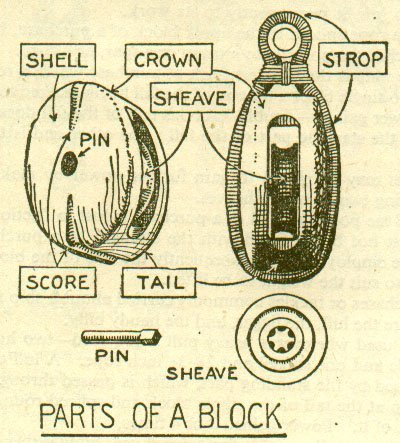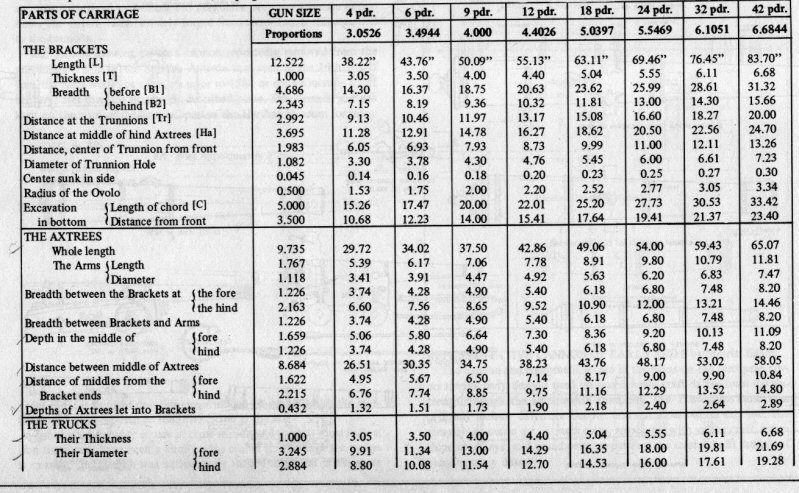-
Posts
8,057 -
Joined
-
Last visited
Content Type
Profiles
Forums
Gallery
Events
Posts posted by allanyed
-
-
17 hours ago, dvm27 said:
the actual cannon depicted which has right hand laid rope
FWIW, confirming Greg's observation, all the breech rope in the drawings in Caruana's The History of English Sea Ordnance are right hand twist rather than cable laid.
Allan
- thibaultron and mtaylor
-
 2
2
-
3 hours ago, Mike Shea said:
I'm getting ready to tackle OcCre's Edurance (my first wooden ship)
While you have an interesting kit, as this is your first build, you might want to consider setting it aside for now and get at least one or two high quality beginner kits such as the from the three vessel series at Model Shipways designed by master shipwright David Antscherl. They will teach you techniques and more that will last a lifetime.
Allan
-
-
Overall VERY neatly done! You may want to redo the blocks under the tops as they appear to be upside down so the line would rub against the tail rather than over the would be sheave. It may be easier to just drill the upper holes rather than unrig and re-rig.
Allan

- Ryland Craze, TJM and Thukydides
-
 3
3
-
18 hours ago, modeller_masa said:
I haven't seen a real block,
Not sure if you were joking, but there are hundreds at RMG. One example..... https://www.rmg.co.uk/collections/objects/rmgc-object-257672
Allan
- modeller_masa, mtaylor and davyboy
-
 3
3
-
The inboard profile plan actually showing one example of the side half door lids and the remaining four with no lids seems a little unusual when looking at other sets of profile or inboard profile plans the majority of which show no types of lids. Maybe it is shown because it is a side half door lid rather than the more common single lid hinged at the top. Peter Goodwin mentions that the side half door lids were sometimes used as they gave a certain extent of protection to the shrouds and deadeyes from heat and sparks discharged from the guns. Then again, maybe all the ports had side opening lids and the example is to show that feature. I for one am curious and hope someone has an answer based on contemporary sources.
For an interesting drawing see ZAZ 5578 of the bomb vessel Grampus. It shows both three piece incendiary and escape port lids and a drop lid.
https://www.rmg.co.uk/collections/objects/rmgc-object-85369
Allan
-
The barrels look super Srenner.
Allan
-
The Vanguard kits really are superior and yours looks great. Would the Flirt have had wooden hoops nailed to the mast on the top and bottom of the wooldings or were the wooldings just nailed to the masts to keep them in place without the hoops?
Allan
-
A very warm welcome to MSW Mimmo
Allan
- Keith Black and mtaylor
-
 2
2
-
Welcome to MSW Johann. I have fond memories of Chile, especially Valparaiso, for the fishing, the Casino de Vina del Mar and other fun stuff.
Allan
- mtaylor and Keith Black
-
 2
2
-
Yessir, it does. While the taper, as you move forward from the head of the stem, is not difficult to make, the narrowing from top to bottom may be problematic. While the tapering from the stem to the foremost edge of the knee of the head is quite noticeable I would guess that few viewers will know about or notice if the vertical tapering is not present so maybe best to leave it alone.
Out of curiosity, what is the width of the keel? Establishment scantlings call for a width of 12" midships where it is actually 12" square, 10.5" wide at the stem, and 7.5" at the stern post. At your scale of 1:100 -- 3mm midships, 2.7 mm at the stem, and about 2 mm at the stern post.
This may all be of little importance for now, but maybe something to consider for future builds.
Allan
- tennfox and Old Collingwood
-
 2
2
-
4 hours ago, tennfox said:
Im very new to the ship building lingo, Could you explaint "knee of the head"?
Picture and a 1000 words.......... The dimensions in the lower sketch are for a 20 gun ship built to the 1719 English Admiralty Establishment, but varied very little in later years.
Allan
- Old Collingwood and tennfox
-
 2
2
-
Looking good Tennfox!
Don't forget to taper the knee of the head. This is is not commonly shown or explained in kits, Syren and Vanguard being exceptions. There may be others, but most are unaware or ignore this, resulting in the forward most part of the knee of the head being much too broad. In the case of Greyhound (Protector), assuming the stem is sided 14" at the head as specified in the 1719 Establishment for a 20 gun ship, the knee of the head would taper to about 5.5 inches full scale (0.055" -- 1.4mm at 1:100)
Allan
-
-
Your blocks look nice and they bring up a couple questions for me. What is a good paint to coat resin (if these are resin) blocks? Also, can these be treated in a sanding drum like wooden blocks can be shaped with a sanding drum to reduce or eliminate the flat areas?
Allan
- druxey, mtaylor, modeller_masa and 1 other
-
 4
4
-
As you know there was some good discussion on carriages in https://modelshipworld.com/topic/36122-help-with-9lb-cannon-carraiges-long-9s/#comment-1031305 Also, The following chart MAY be helpful, but it does not show bracket lengths for various barrel lengths. The other dimensions might be helpful though.
Allan


-
13 hours ago, modeller_masa said:
What kind of block should I make? There are thousands of different types of blocks.
What ship and year? Blocks from the 18th century are very different from blocks of the later 19th century for example. Your photo shows externally stropped blocks as well as internally stropped blocks which came later. There is also the matter of single stropped and double stopped blocks, clue blocks, sheet blocks &c. For blocks up to at least 1860 pages 162 to 167 in James Lees Masting and Rigging English Ships of War there are very good drawings of many types that you might need to buy or make. Lees also give dimensional ratios for some blocks.
Allan
- cotrecerf, mtaylor, modeller_masa and 1 other
-
 4
4
-
Your Indy continues to be an inspiration!
If you have not already seen them you may find the plans of 28 foot and 32 foot pinnaces from RMG helpful as well. ZAZ7175 (low res) on the RMG Collections site and ZAZ173 (High res with list of scantlings on the Wiki Commons site.) The RMG plans are a little later than Indy so it might be have changed but ZAZ7175 shows every thwart has one thole set, alternating from port to starboard rather than two sets of tholes on every other thwart as it was single banked.
Allan
- Blue Ensign, mtaylor and Theodosius
-
 3
3
-
WELCOME TO MSW!!!!!
English please as many members do not speak Spanish. Google translator or other on-line translation websites work really well for the most part. The moderators will likely remove your email address in your post to save you from spammers. You can also send a private message to other members by clicking on their name if you do not want to post for the entire membership. The symposium sounds like a great gathering😀.
Allan
I hope the following translation is close.
Hello Isidro. My name is Guillermo Gefaell and I am a naval engineer. Your father was a naval engineer and worked in Barreras in the 70s? If so, I met him and I liked him very much. I would like to contact you to inform you about a Symposium on Historic Ships that we have organized and that will take place at the Madrid Naval School on April 24 and 25. My email is XXXXXXXXXXXX A cordial greeting.
-
VERY NICE model. Question for your followers: How do you get the reef points to hang straight down so they are not sticking out away from the sails? I have had some success wetting the line in diluted white glue (or lacquer) and weighing each down with a small clip until it dries. If anyone has an alternative, that would be of great interest.
Thanks in advance
Allan
-
Kai,
LOVELY first build! Changing to the Syren blocks was a wise decision.
Question regarding the gammoning as I have not seen it done this way on any contemporary model or any drawings based on contemporary sources. Is this a kit instruction or was this actually done this way in some cases?
Thanks
Allan
-
Bienvenu Mic! Hope to see your work in the near future.
Allan
- Long John Silver, Keith Black, Vlax and 1 other
-
 4
4
-
-




HMS Indefatigable 1794 by Blue Ensign - FINISHED - Vanguard Models - 1:64 scale
in - Kit build logs for subjects built from 1751 - 1800
Posted · Edited by allanyed
That is a really fine looking boat. I realize it may not be all that important and it is a kit convention but I do wonder why there is no keelson on which the mast steps would sit rather than on the footwaling. For the late 18th century/early 19th century for a 32 foot pinnace the keelson would be about 11 inches broad by 1 1/4" thick according to the scantlings given in The Boats of Men of War by May where as the footwaling would be closer to 3/4" thick and not as broad. Early 18th century keelson for a 32 foot pinnace was about 8"X1.5" and the footwaling 4"X1" (The Boats of Men of War, page 53.) Whichever the case, there is quite a difference between the keelson and footwaling breadth and thickness. There are some cross sections of boats at RMG where this can be seen. One example follows.
Allan